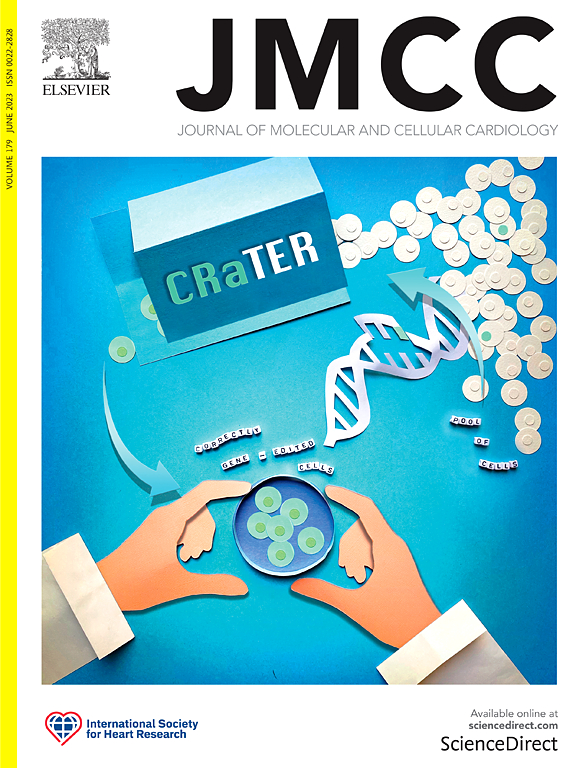细胞质突变体RBM20引起小鼠心房心律失常。
IF 4.7
2区 医学
Q1 CARDIAC & CARDIOVASCULAR SYSTEMS
引用次数: 0
摘要
RNA结合基序蛋白20 (RBM20)是心肌细胞中关键的剪接调节因子,其RSRSP结构域的突变与严重扩张型心肌病(DCM)和房颤(AF)的高患病率相关。长期以来,RBM20突变被认为是通过其功能丧失对靶基因剪接的干扰而导致DCM。然而,最近的研究强调,突变体RBM20的功能获得,独立于剪接缺陷,也可能在DCM的发病机制中发挥关键作用。尽管有这些发现,突变体RBM20的功能获得对房颤发展的贡献仍然知之甚少。在这项研究中,我们旨在通过建立一种新的心房特异性RBM20突变表达小鼠模型(SlnCre/+;LSL-Rbm20S637A老鼠)。这些小鼠在心房中特异性表达突变的RBM20,同时维持RBM20依赖性的选择性剪接。分析显示,尽管在SlnCre/+中没有心房结构重构或心力衰竭,但心房心动过速的自发发展和AF的诱导性增加;LSL-Rbm20S637A老鼠。观察到心房传导速度降低,同时连接蛋白43的表达减少和错位,以及Ca2+处理异常和Ca2+处理蛋白磷酸化改变。这些发现表明,突变体RBM20通过独立于剪接调节的机制参与心律失常,涉及小鼠心房Ca2+处理和电传导特性的改变。本文章由计算机程序翻译,如有差异,请以英文原文为准。

Cytoplasmic mutant RBM20 causes arrhythmogenicity in murine atria.
RNA binding motif protein 20 (RBM20) is a critical splicing regulator in cardiomyocytes, and mutations in its RSRSP domain are associated with severe dilated cardiomyopathy (DCM) and a high prevalence of atrial fibrillation (AF). RBM20 mutation has long been thought to cause DCM through the disturbed splicing of the target genes by its loss of function. However, recent studies have highlighted that the gain of function of mutant RBM20, independent of splicing defects, may also play a critical role in the pathogenesis of DCM. Despite these findings, the contribution of the gain of function of mutant RBM20 to the development of AF remains poorly understood. In this study, we aimed to elucidate the contribution of mutant RBM20 in atrial arrhythmogenicity by generating a novel atrial-specific mutant RBM20-expressing mouse model (SlnCre/+; LSL-Rbm20S637A mice). These mice specifically expressed mutant RBM20 in the atria while maintaining RBM20-dependent alternative splicing. Analyses revealed the spontaneous development of atrial tachycardia and increased inducibility of AF, despite the absence of atrial structural remodeling or heart failure in SlnCre/+; LSL-Rbm20S637A mice. Reduced atrial conduction velocity was observed, along with decreased and mislocalized expression of connexin 43, as well as abnormal Ca2+ handling and altered phosphorylation of Ca2+-handling proteins. These findings suggest that mutant RBM20 contributes to the arrhythmogenicity through mechanisms independent of splicing regulation, involving alterations in Ca2+ handling and electrical conduction property in murine atria.
求助全文
通过发布文献求助,成功后即可免费获取论文全文。
去求助
来源期刊
CiteScore
10.70
自引率
0.00%
发文量
171
审稿时长
42 days
期刊介绍:
The Journal of Molecular and Cellular Cardiology publishes work advancing knowledge of the mechanisms responsible for both normal and diseased cardiovascular function. To this end papers are published in all relevant areas. These include (but are not limited to): structural biology; genetics; proteomics; morphology; stem cells; molecular biology; metabolism; biophysics; bioengineering; computational modeling and systems analysis; electrophysiology; pharmacology and physiology. Papers are encouraged with both basic and translational approaches. The journal is directed not only to basic scientists but also to clinical cardiologists who wish to follow the rapidly advancing frontiers of basic knowledge of the heart and circulation.

 求助内容:
求助内容: 应助结果提醒方式:
应助结果提醒方式:


